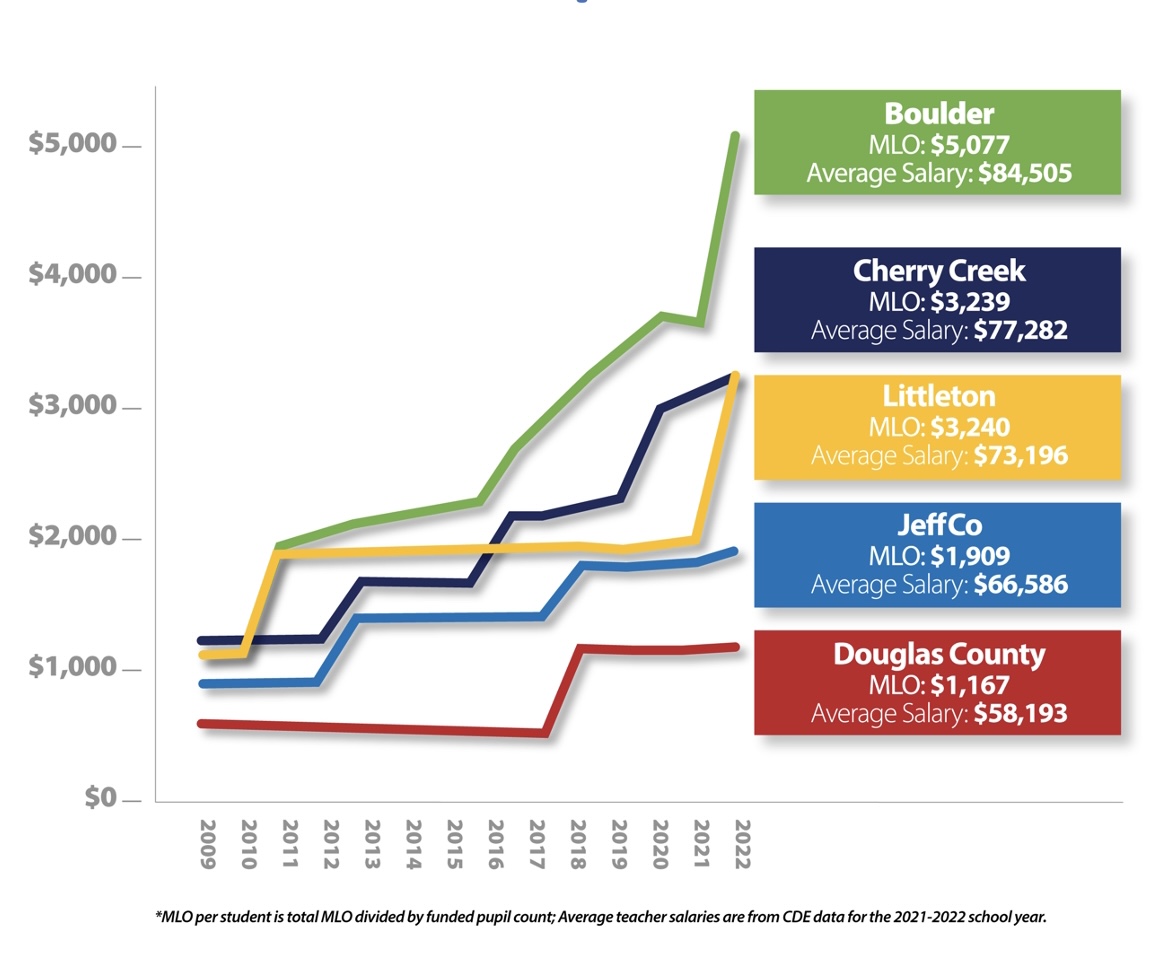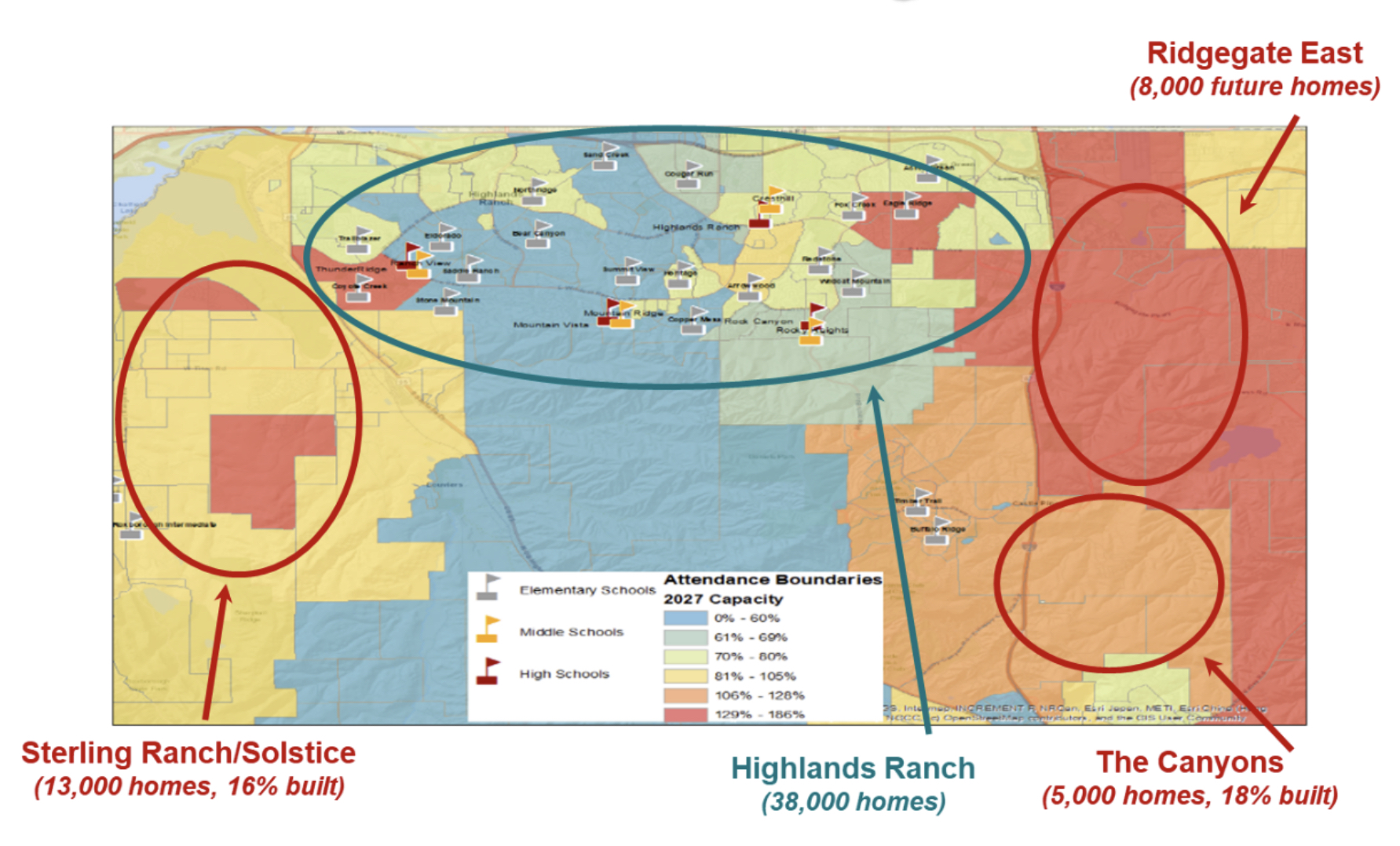Frequently Asked Questions

Q. Why is DCSD going to the voters for approval of additional funding?
A. Only once in the last 17 years have Douglas County voters approved additional local funding for our schools, teachers, and students. As a result, DCSD is losing experienced teachers and other essential employees to better-paying school districts; implementing rolling cancellations for bus service because of a severe bus driver shortage; experiencing an increase in class size year over year due to lack of teacher applicants; deferring critical repairs, maintenance and capital expenditures; and experiencing overcrowded classrooms in many parts of the District. DCSD has fallen behind our neighbors (Cherry Creek, Littleton, Jeffco) in terms of local funding, which has a direct impact on DCSD’s ability to compete for teachers and staff and maintain academic excellence. Additionally, DCSD has been unable to support building maintenance, technology, security upgrades, buses, and other capital needs out of its general fund. To implement short-term strategies to retain critical staff and to make much-needed repairs, DCSD is spending from reserves.
Q. What are the two school finance ballot questions voters will be asked to approve?
A. To address these urgent needs, the Douglas County School District Board of Education unanimously approved a resolution to place two finance questions on the ballot this fall – a $66 million mill levy override (MLO) and a $484 million bond package.If approved by the voters this fall, the MLO proceeds will be used to provide competitive wages to better recruit and retain staff – including teachers, custodians, bus drivers, andschool security support. The bond package includes security upgrades, facility improvements at every neighborhood school, urgent facility improvements at charter schools, construction of three new elementary schools, expansion of two middle schools, a facility upgrade for children with special needs, and career and technical education improvements. All capital needs are listed in the bond plan on the DCSD website.

Q. How will the funds be allocated from the mill levy override (Ballot Issue 5A)?
A. If 5A passes $60 million will be spent on compensation and benefits for teachers and other staff, making DCSD more competitive with better-paying school districts. (DCSD’s average teacher salary is about $19,000 behind neighboring districts and its starting teacher pay is only $45,209.) DCSD’s inability to hire and retain good teachers reducesstudent achievement and increases class sizes. $6 million will be spent to increase and maintain security support for all schools including the District’s School Resource Officer (SRO) program. These uniformed local law enforcement officers provide a visible presence during the school day and at events. The District’s 18 charter schools – representing 24% of our student population – each year will share $15.8 million from the total $66 million in MLO proceeds for staff compensation and added security. Passing 5A is critical to hire to retain good teachers and staff, ensure continued academic excellence, and maintain reasonable class sizes.
Q. How will money raised by the bond (Ballot Issue 5B) be spent?
A. Every neighborhood school and most charter schools in DCSD will benefit in some way from the $484 million in new revenue if the bond question passes. The main elements of the bond package include: $226 million to build three new elementary schools and expand two middle schools; $145 million to address a maintenance and repair backlog that includes urgent repairs to mechanical and electrical systems, roofs, intercom systems, parking lots and playgrounds; $15.4 million in safety equipment replacements and upgrades and modifications to create more secure buildings; and $25.6 million to enhance DCSD’s career and technical education (including the trades) offerings for students. The bond also includes funding for urgent needs to support special education, information technology, athletic and activity upgrades, and buses. The bond proceeds will allow DCSD to create many cost-saving efficiencies to our school buildings. For example, energy-efficient equipment would replace old equipment, lowering DCSD’s utility bills. Keeping school roofs from leaking will save the Districtfrom having to repair damaged interiors. Voter approval of 5B is needed to address overcrowded classrooms; keep up with critical facility upgrades, repairs and maintenance; and create more secure environments for our students.
Q. Where will the new elementary schools be built?
A. If 5B passes, new elementary schools will be built in Sterling Ranch, The Canyons portion of Castle Pines and the Crystal Valley community south of Castle Rock. These new schools - in addition to added classrooms at Mesa and Sierra middle schools - will alleviate overcrowded schools in neighboring communities.

Q. How does DCSD’s funding level compare with other large school districts?
A. Denver, Jefferson County, Cherry Creek and Littleton Public Schools all receive more local mil levy override funding per student than DCSD. The three sources of school district funding are state revenue, local property tax revenue (which, together, make up each district’s allowance under the School Finance Act) and local mill levy override revenue (over and above the SFA allowance). While DCSD’s SFA allowance is roughly even with other large Metro area school districts, DCSD’s mill levy override revenue – which must be approved by local voters – is far lower than what voters in these other school districts have approved. For example, DCSD collects $2,000 per student less per year in local MLO revenue than Cherry Creek and Littleton.
Q. Can DCSD “cut the fat” elsewhere in its budget instead of going to the voters for a bond and MLO?
A. DCSD is already running very lean. The District often spends from reserves to keep up with capital expenditures, repairs, and teacher retention. According to the Colorado Department of Education, DCSD spends $63 per student on general administrative costs, which is far lower than each of its counterparts in the Metro area – Denver ($184), Boulder ($149), Littleton ($149), and Cherry Creek ($130). In fact, DCSD’s general administrative costs comprise just .06% of its total budget.
Q. With local property taxes going up, isn’t DCSD getting more revenue?
A. Unfortunately, the increase in property taxes we are experiencing here in Douglas County doesn’t provide our schools with more revenue. Each year, under the School Finance Act (SFA), the state legislature determines the total funding allowance (funded by local property tax and backfilled by the state) for each school district. In the SFA funding model, as the local share of property tax increases, the state share decreases by the same amount so as not exceed the total funding allowance. However, state law allows school districts to request additional local funding from its voters through a mill levy override, providing funds over and above the SFA allowance.
Q. How were the expenditures in the bond and mill levy override proposals determined?
A. The bond and MLO packages are the result of considerable community input, recommendations from DCSD leadership, and spending plans unanimously approved by the Board of Education. In February 2022, DCSD convened the 24-member Mill Bond Exploratory Committee (MBEC) to make recommendations to DSCD on funding needs. These community members conducted a comprehensive 15-month process that included school visits, hours of public input and ultimately a formal report that was presented to the DCSD board of education.

Q. How much will these two school funding issues cost the owner of a median-priced home?
A. If voters approve both the mill levy (Issue 5A) and bond (Issue 5B) questions, the owner of a $700,000 home in Douglas County School District will pay an additional $11.67 per month. For pennies a day for both ballot questions we can help provide the safe learning environment our students and teachers deserve.
Q. How do DCSD school tax rates compare with other school districts?
A. At 42.836 mills, homeowners in Douglas County pay among the lowest school tax rates in the Denver Metro area. In fact, should DCSD’s ballot issues 5A and 5B pass this November, our mill levy rate will still be lower than Denver, Cherry Creek, Littleton and Boulder Valley School Districts.
Q. Other than teachers, what other hiring challenges is DCSD facing?
A. Not only is DCSD losing great teachers to higher-paying school districts, they are also unable to fill custodian, bus driver, campus security specialist and food service positions. In this competitive market for employees, many support staff can earn higher salaries working at retail stores and restaurants. DCSD’s severe bus driver shortage, for example, means consolidating school bus routes, rotating cancelled bus routes, adding stops, and lengthening the time it takes students to get to school and home again.
Q. What specific increases will teachers and staff receive if the Mill Levy Override (5A) passes?
A. Teachers will receive, on average, a 9% increase. Support staff, including education assistants, custodians, bus drivers, and kitchen staff will receive a 9% increase. All other regular staff will receive a 7% increase.

Q. Why is DCSD proposing to build new schools when overall district enrollment has slightly declined in recent years?
A. While overall enrollment has slightly declined in recent years, some areas of our school district are experiencing tremendous growth with new homes that are marketed to young families. While in some parts of Highlands Ranch DCSD schools are underattended, there are no schools in fast-growing communities like Sterling Ranch, The Canyons, and Crystal Valley. Whether by school bus or by car, students in these parts of Douglas County currently travel up to 45 minutes each way to and from schools in surrounding communities. New schools are needed to avoid continued overflow busing to already overcrowded classrooms. The fast growth in Crystal Valley andnorthern Parker also requires adding classrooms to Mesa and Sierra Middle Schools.These new elementary schools and middle school expansions will address student growth where it’s happening, shorten bus routes and provide our kids with safe, adequate spaces to learn.
Q. Can DCSD just add more modular classrooms to prevent overcrowding?
A. Modular classrooms are not part of the District’s long-term strategy to address our growing student population. DCSD uses tailer-like mobile classrooms to provide temporary additional capacity at some schools. However, the number of additional seats provided by these mobile classrooms is very limited. Also, these structures are not ofthe same quality as permanent construction. They are made of plywood, not as well insulated as a school building, and often have no restrooms or drinking fountains.
Q. What happens if the voters don’t approve 5A and 5B?
A. If ballot questions 5A and 5B fail, our schools will continue to lose experienced, qualified teachers to surrounding school districts, additional safety and security measures may be postponed indefinitely, and DCSD’s school maintenance and repair backlog will continue to grow. The loss of and inability to recruit quality staff will eventually degrade the quality of our schools and our home values. Cherry Creek School District pays teacher salaries that are on average 32% higher than what DCSD can afford. Teacher pay gaps with Cherry Creek and other districts means DCSD will have to consolidate classes at schools with fewer teachers. Other consequences include continued increase in class size; inability of DCSD to expand safety and security programs, such as School Resource Officer (SRO) coverage at elementary schools; and continued bus transportation rationing.

Q. How can DCSD assure its taxpayers that the revenue from these school funding measures will be spent as promised?
A. Ballot language for both the MLO and bond ballot questions require that the Districtexpenditures “be subject to oversight by a citizens’ committee.” In 2018, the most recent year a bond/mill levy override was passed in DCSD, the District convened the Mill Bond Oversight Committee (MBOC). Comprised of a diverse group of community volunteers, the MBOC convened on a regular basis and met with district staff for over four years to review all projects and ensure that mill levy override and bond expenditures were in alignment with ballot language approved by the voters. On August 22nd the MBOC presented their annual report to the Board of Education and briefed the board that all expenditures were in alignment with the ballot language. This year’s ballot language for 5A and 5B legally requires the Board of Education to reestablish the MBOC to monitor the detailed progress of the improvements and programs being implemented with new funds.
Also in August the Board of Education approved a specific bond plan, outlining each expenditure, and specific post-MLO salary schedules and increases. Both the post-MLO salary schedules and detailed bond plan are available on the DCSD website.
Q. Besides the MBOC, what other volunteer advisory committees inform the work of DCSD?
A. In addition to the MBOC, there are dozens of community volunteers who leverage their professional expertise on behalf of our schools via three other advisory committees. While the Board of Education and the Superintendent have ultimate responsibility for the financial condition of DCSD, the professionals who sit on these committees make recommendations. The Long Range Planning Committee (LRPC) is comprised of over 20 citizens who participate in development of the District’s annual master capital plan. The LRPC produces a detailed analysis of current and future needs of our schools. The Fiscal Oversight Committee (FOC) is composed of financial experts who provide guidance on the financial well-being of DCSD. The FOC makes recommendations on DCSD’s accounting, banking, financial reporting and operating and capital budget. The District Accountability Committee (DAC) helps collect feedback from School Accountability Committees and advises the BOE on spending priorities, school improvement, and more. The charter school community is represented on these committees.

Q. What are the consequences for our students when DCSD can’t hire enough teachers?
A. Losing long-time, qualified teachers to other school districts affects our students’ academic achievement and readiness for post-secondary success. The experience our veteran teachers bring to our classrooms cannot be overstated. Our best teachers are the ones who have spent years mentoring, instructing and caring for our students. With fewer teachers to educate our students, class size will continue to increase which will adversely affect our students’ ability to learn.
